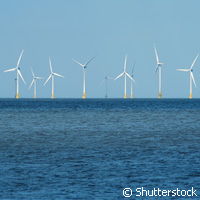European researchers pushing the boundaries of floating wind-turbine development
The latest stage in an EU-funded project into the development of offshore wind-turbines is about to get under way off the coast of Spain. A test platform off the Bay of Biscay will be constructed, led by researchers from Stiftelsen for industriell og teknisk forskning (SINTEF) Energy Research in Norway, one of the 19 partners making up the pan-European consortium who are carrying out the project. The five-year project, titled 'High power, high reliability offshore wind technology' (HIPRWIND), started in November 2010 and has been made possible in part thanks to EUR 11 million of funding from the EU under the 'Energy' Thematic area of the Seventh Framework Programme (FP7). The overall aim of the project is to lay the foundations for the delivery of complete, fully functioning industrial-scale offshore wind-turbines capable of generating between 10 MW and 20 MW of energy. To put this figure into context, modern land-based wind turbines can currently achieve between 300kW and 6 MW of power. The construction of the test platform off the Spanish coast will be one of the first indicators of how on track the HIPRWIND project is. 'In order to test the latest research results, we are constructing a 1 MW test platform in the Bay of Biscay off the north of Spain,' says Matthias Hofmann at SINTEF Energy Research. 'This will be ready in three years and will help us to close the energy gap and take the step from small-scale testing to a full-scale offshore installation.' There are many differences between designing a wind-turbine for use on land compared to one designed to float in open water. For example, challenges will emerge in the design of the rotor blades and control systems. The researchers also need to find a way for floating wind-turbines to operate as independently as possible. 'It is not enough to simply have wind turbines offshore; operating and maintaining them will involve challenges, such as simply reaching them. When seas are high, for example, it will be difficult to get "on board" for trouble-shooting and maintenance,' explains Harald Svendsen, another researcher from SINTEF Energy Research. Aside from building and maintaining them, the researchers will also need to investigate different ways of connecting a floating wind-turbine to the electricity grid onshore. The researchers will have to find out how to lose the minimal amount of energy during transfer as well as ensure strict quality requirements are met regarding the supply of power. Although there are already offshore wind turbines in operation - in Denmark and the United Kingdom - these stand in shallow water close to the coast. In the future, as coastal areas become more crowded, these will need to be located further out to sea, which will also be better for the environment. Offshore wind turbines also offer many advantages in terms of resources, the most obvious being that out at sea winds are harder and more powerful, meaning larger schemes can be built that are capable of powering greater land masses compared to their onshore counterparts. The HIPRWIND project will also aim to overcome the gap in technology development between small-scale testing and full-scale offshore deployment. Thus HIPRWIND will significantly reduce the risk and cost of deep offshore technology commercialisation. The researchers can make use of two existing offshore test areas with a favourable permitting situation and suitable infrastructure, such as the grid connection and monitoring facilities. The full impact of the project is ensured by strong participation from both leading industrial partners, and research and development stakeholders from the offshore-maritime and the wind energy sector, with a strong background in harsh environment industrial developments. The consortium is made up of partners from Belgium, France, Germany, the Netherlands, Norway, Spain, Switzerland and the United Kingdom. //CPA For more information, please visit: SINTEF Energy Research: http://www.sintef.no/Home/
Countries
Belgium, Switzerland, Germany, Spain, France, Netherlands, Norway, United Kingdom



